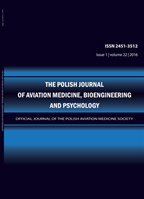2016, Volume 22, Issue 1
Reflectance Method for a Wearable Photoplethysmographic Sensor – Experimental Evaluation
Tadeusz SONDEJ1, Krzysztof RÓŻANOWSKI2, Dominik SONDEJ1
-------------------------------------------------------------------------------------------------
1Electronic Department, Military University of Technology
2Aviation Bioengineering Department, Military Institute of Aviation Medicine
Autor korenspondencyjny: Tadeusz SONDEJ; Electronic Department, Military University of Technology; email: tadeusz.sondej[at]wat.edu.pl
Full text
Streszczenie
Introduction: The article presents the design and testing results of a photoplethysmographic
signal sensor intended for use in everyday activities.
Methods: The design of the sensor involved a commercial DCM03 sensor based on the
reflectance method and a fully integrated analog, front-end AFE4490. Determination of the
photoplethysmographic signal and calculation of heart rate was based on appropriate data
processing algorithms including digital filters, signal segmentation, moving average and
variable baseline.
Results: Measurements were carried out in different sensor placement locations as well as
during specific body motions. Detailed analysis of the recorded signal was performed using
the proposed processing methods and the fast Fourier transform technique.
Discussion and Conclusion: Based on our results, it is possible to measure HR values and
determine the photoplethysmographic curve under dynamic conditions. On the other hand
measurement of blood oxygen saturation is subject to significant limitations.
Słowa kluczowe
pulse oximetry, reflectance sensor, photoplethysmography, wearable sensor, PPG
